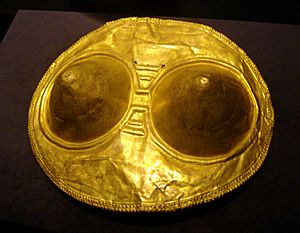Tumbaga facts for kids
Tumbaga is a special type of metal. It is a mix, or alloy, of gold and copper. Spanish explorers, called Conquistadors, gave it this name. They found it used a lot by ancient cultures in pre-Columbian Mesoamerica (parts of North America) and South America.
The word "tumbaga" likely comes from the Malay word tembaga. This word means "copper" or "brass". You might also see it spelled tumbago in old books.
What is Tumbaga Made Of?
Tumbaga is mostly made of gold and copper. It melts at a much lower temperature than pure gold or pure copper. This makes it easier to work with. Tumbaga is also stronger than pure copper. Even after being hammered flat, it stays easy to shape. This is called being malleable.
You can treat tumbaga with a simple acid, like citric acid (found in lemons). This acid dissolves the copper from the surface. What's left is a shiny layer of almost pure gold. This gold layer sits on top of the stronger copper-gold mix. This special process is known as depletion gilding. It makes the metal look like solid gold, even if it's mostly copper inside!
How Was Tumbaga Used?
Ancient cultures in South and Central America used tumbaga a lot. They made many religious items from it. Tumbaga was a very useful metal. People could shape it in many ways:
- They could cast it into molds.
- They could stretch it into wires.
- They could hammer it flat.
- They could make it look like gold (gilding).
- They could join pieces together (soldering or welding).
- They could make it harder or softer.
- They could polish it to make it shiny.
- They could carve designs into it.
- They could raise patterns on its surface.
- They could add other materials into it.
The amount of gold and copper in tumbaga objects changed a lot. Some items had as much as 97% gold. Others had 97% copper! Sometimes, other metals were also found in tumbaga. These could make up to 18% of the total metal.
Often, tumbaga objects were made using two main steps:
- First, they used the lost wax technique. This is where a wax model is covered in clay. The wax is melted out, leaving a mold. Then, the melted tumbaga is poured into the mold.
- Second, they used depletion gilding. After the object was cast, it was heated. This turned the copper on the surface into copper oxide. This oxide was then rubbed off. Next, the object was put into a special liquid. This liquid dissolved any silver, leaving only gold on the surface. If you looked closely, you could see tiny holes where the copper and silver used to be.
The "Tumbaga" Shipwreck
In 1992, something exciting was found near Grand Bahama Island. About 200 silver "tumbaga" bars were discovered in a shipwreck. These bars were mostly made of silver, copper, and gold.
The Spaniards had taken these metals during their conquests led by Cortés. They quickly melted the metals into tumbaga bars. This made them easier to carry across the Atlantic Ocean back to Spain. Once in Spain, these bars were usually melted down again. This separated the metals back into pure silver, copper, and gold.
See also
 In Spanish: Tumbaga para niños
In Spanish: Tumbaga para niños


